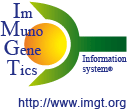NK cell receptors
Natural killer (NK) cells are important lineage of lymphocytes that have a role in anti-tumour and antiviral immunity. The effector function of NK cells is tightly regulated by signalling pathways associated with activating and inhibitory receptors. There are two structurally distinct superfamilies of NK cell receptors:
- the KIR or Killer cell immunoglobulin-like Receptors (in French)
- the NKG or C-type lectine-like receptors (in French).
The crystal structures of 3 KIR (KIR2DL1, 2DL2, 2DL3) and two NKG (human CD94 and murine Ly49A in complex with H-2Dd) have been determined.
There are activating and inhibitory receptors in both structural families.
1. Inhibitory receptors
Inhibitory receptors have been identified in mouse and humans. The "inhibitory" receptors bind to MHC class I (MHC-I) on the target cell and possess, in their cytoplasmic region, an ITIM.
(i) Inhibitory NKG receptors comprise mouse Ly49A and human CD94-NKG2A, which recognise class
I H-2Dd and HLA-E, respectively.
(ii) Inhibitory KIR receptors include
KIR2DL1-3, KIR3DL1 and KIR3DL2, which recognise the HLA-C, HLA-B and HLA-A MHC class I.
In addition to the MHC class I specific inhibitory receptors, there are IgS inhibitory receptors expressed by NK cells and other haematopoietic cells that recognise non-MHC ligands, such as LAIR-1 and members of the LILR/ILT family of cell surface receptors.
Inhibitory receptors mediate their suppressive effect via the recruitment of SH2-domain containing protein tyrosine phosphatases SHP-1 and SHP-2 to the ITIM present in the cytoplasmic region of these receptors. Thus, ligation of inhibitory receptors results in SHP-1 or SHP-2-mediated dephosphorylation of components of activating intracellular signalling cascades such as TcRζ , ZAP70 and Syk, as well as preventing the formation of a LAT/PLCγ complex. Consequently, NK cell cytotoxicity is reduced.
2. Activating receptors
KIR activating receptors include KIR2DS1 and KIR3DS1.
NKG activating receptors
include CD94-NKG2C and NKG2D.
These receptos are MHC class I or class-I-like
specific.
Intracellular signalling initiated via some of the activating receptors involves the recruitment of signal-transducing modules, such as CD3ζ, FcRγ chain and DAP12, which contain ITAM that, once phosphorylated, recruit the protein tyrosine kinases ZAP70 or Syk and initiate downstream signalling pathways.
Receptors, that contribute to the activation of human and mouse NK cells, include 2B4, CD16, DNAM-1, CD2, CD44, CD69, NKp30, NKp44 and NKp46.
An interesting feature of the cytoplasmic domains of 2B4 and SLAM is the presence of two or more unique tyrosine-based motifs that resemble motifs presents in activating and inhibitory receptors. The motifs in 2B4 and SLAM can recruit the SH2-domain containing proteins SHP-2 and SAP (SLAM-associated protein).
- Les motifs ITIM (IMGT Lexique)
- KIR and ILT/LIR receptors (IMGT Lexique)
- Récepteurs des cellules NK ayant un domaine de type lectine : récepteurs NKG (12p13.2) (IMGT Education)
- Récepteurs des cellules NK ayant des domaines Ig-like : KIR (19q13.42) (IMGT Education)
- Nomenclature of the human LRC (Leucocyte Receptor Complex) genes (IMGT Education)



